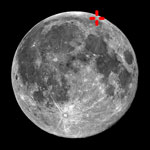|
|||||||
|
|
|||||||
|
Arnold is a lunar crater that is located in the north-northeastern part of the visible Moon, near the lunar limb. This location gives the crater a notably oval appearance due to foreshortening, although the formation is actually relatively round. It lies to the northeast of the Mare Frigoris, to the north of Democritus crater. West of Arnold is the smaller Moigno crater. The ancient rim of Arnold has been worn and rounded by ages of subsequent bombardment. There is a gap in the wall to the southwest, marked by the tiny crater 'Arnold J', and the wall is relatively low along the eastern edge. The northern half of the rim is the most intact, particularly to the northeast where is joins satellite crater 'Arnold A'. The inner floor of Arnold crater has been resurfaced by lava, and is relatively flat except for a number of tiny craterlets. The most notable crater in the interior is 'Arnold F', in the northwest section. If the crater once possessed a central peak, no sign of this feature now remains. |
| ||||||




 (English version,
(English version,
